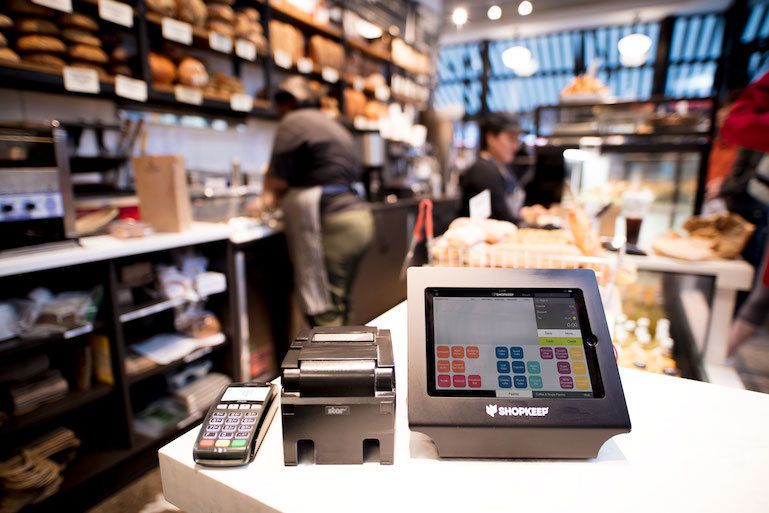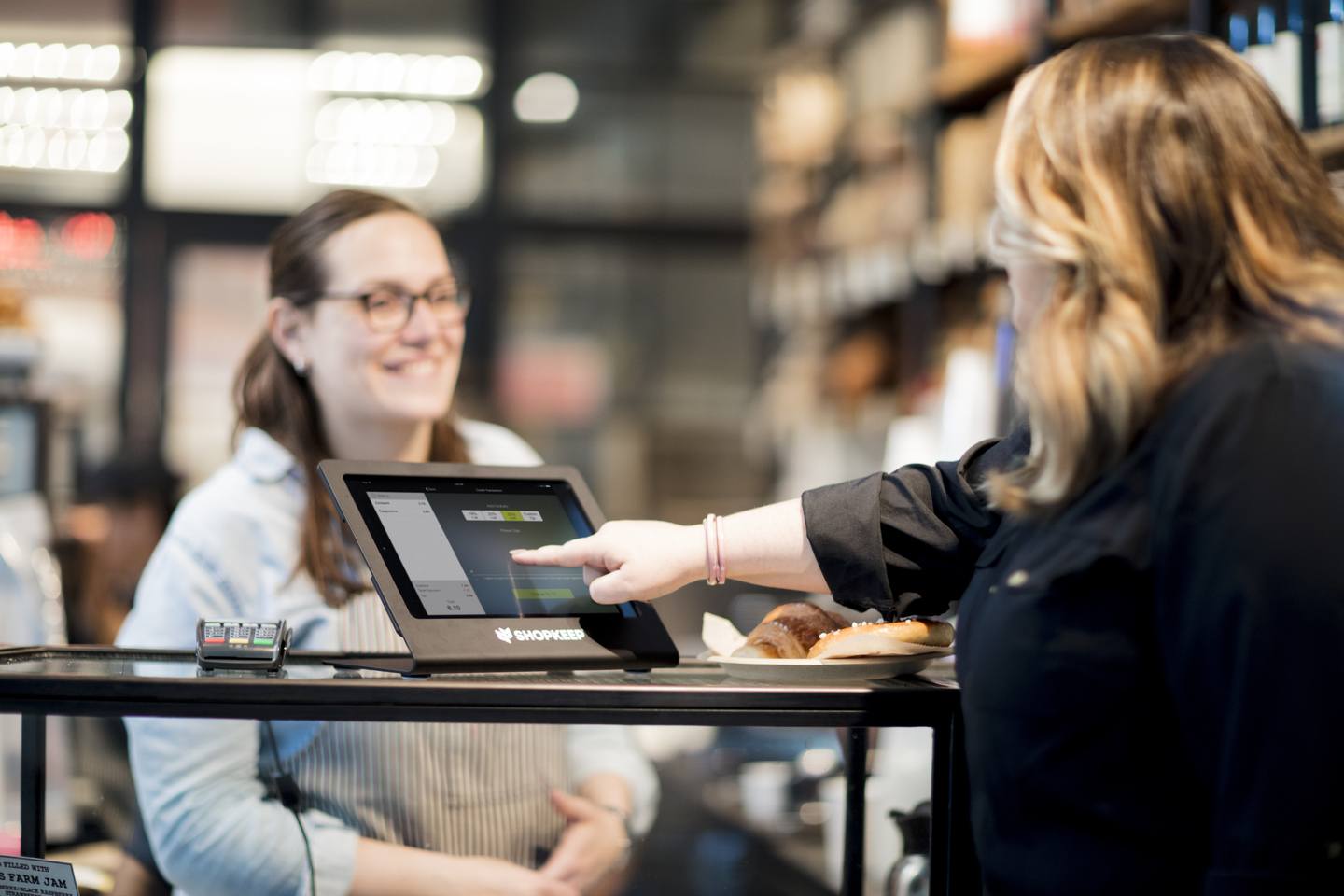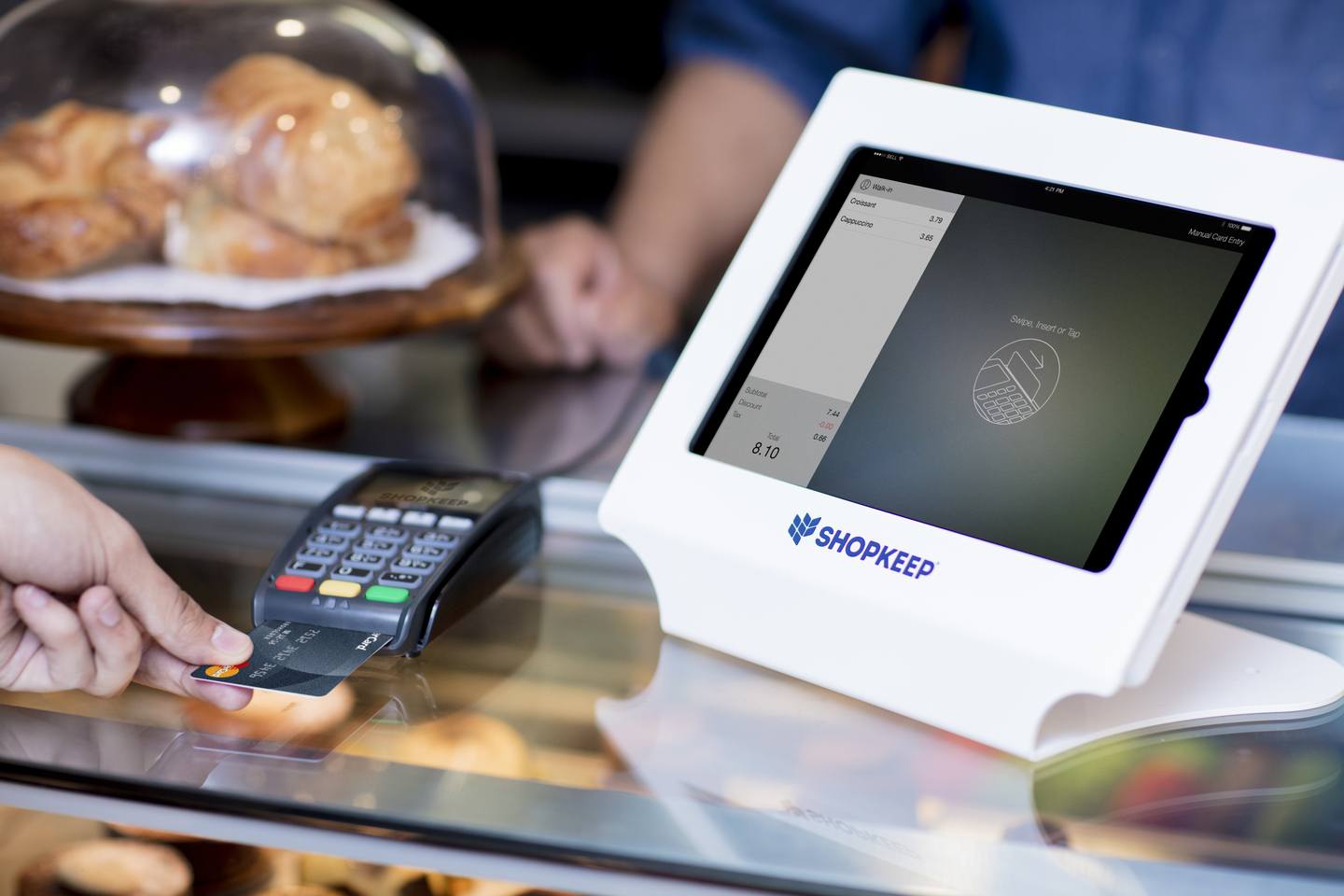
Small Business Basics: What is POS Software?
Imagine this: You’re an independent and driven business owner. Tomorrow you open your first coffee shop in Brooklyn. A killer launch can make or break your future. So, on the eve of your grand opening, how do you envision the first day unfolding?
Is your counter staff struggling to keep up with orders? Is a line of irritated shoppers stretching out the door? Do you spend hours after the close of business trying to balance your cash register?
I’ll bet you see things moving a little more elegantly. A world where orders are processed efficiently, and you balance your register without a hiccup. Maybe you even have a few quiet moments at the day’s end to savor a latte (decaf, of course) and reflect on your success.
If you’re using a traditional electronic cash register, it’s all too easy for the first scene to turn into an unpleasant reality. But it doesn’t have to be that way. There’s a tool that can ensure your grand opening goes off without a hitch. It’s called a point of sale (POS) system. A POS system is a combination of hardware and POS software that helps you run your cafe, restaurant, retail business or other service-based business more efficiently by processing transactions, running sales reports, managing staffing, tracking inventory and much more.
How Does a POS Work?
You’ve likely seen a POS system in the wild. It’s the iPad-based system you use to check out at a local retail business or the register with a large touchscreen that wait staff typically operate in restaurants and bars.
While a complete POS system usually consists of a cash drawer, receipt printer, barcode scanner, credit card swiper, POS software is the specific tool that allows merchants to process sales – typically on a computer, iPad or other tablet device. It’s this powerful POS software that sets these systems apart from traditional electronic cash registers. And it’ll put your Brooklyn coffee shop on a course for world domination.
SEE ALSO: Goldilocks Syndrome? 3 Types of Cash Registers to Choose
Why Use POS Software?
Let’s take a look at the major features and costs associated with point of sale software so that you can better understand the advantages it gives you over an electronic cash register, as well as identify the solution that best fits your budget.
Take Orders in Seconds
Taking complex custom orders using a traditional cash register or pen and paper slows down the checkout experience. POS software allows retailers to easily create and take custom orders, (e.g. large, iced, sugar-free, vanilla latte with skim milk), as well as apply discounts and accept returns.
Many iPad-based point of sale systems also allow you to simplify the inventory layout on your register screen by allowing you to group inventory items and organize them by category. This level of customization can improve the checkout experience by making it easier for cashiers to find items on the register screen. Another common feature is the ability to search for items, giving your team yet another way to speed up the checkout process.
Manage Checks and Orders with Ease
If you run a restaurant or have a food service component to your business, POS software can save you some serious time when it comes to managing checks and ringing up customers. You can easily work on multiple checks at once, open them on one register and close them on another, as well as send orders to a kitchen or bar receipt printer wirelessly without the need to run a paper ticket back to the bar/kitchen. You can also split or merge checks with a few taps in your system versus doing the math on the back of a napkin.
The minutes these features save you on each order can quickly add up to hours that your staff gets back each week, helping your business run more efficiently. It also prevents errors and other customer service issues in the process.
Accept Multiple Types of Payment
POS software gives merchants the flexibility to accept a variety of payment methods like cash, credit card, debit card, and mobile payments like Apple Pay. Plus many systems will even allow you to accept payments when you’re offline, meaning you’ll never miss a sale, even if your internet goes missing.
Monitor Employee Hours
Staff can clock-in and out right from the interface of modern point of sale system, allowing you to track their hours without the need to buy and maintain a separate device and/or piece of software.
Analyze Your Sales with Powerful Reporting
POS software’s truly life-changing feature is the built-in analytics. Many small businesses have never before had access to the level of data that POS software makes available. Here are just a few examples of the kind of information POS software will tell in just a few taps:
- Your store’s total or net sales
- Your top-selling departments or category of products
- Inventory levels
If your POS is cloud-based you typically get even more reporting functionality. You’ll be able track sales or inventory in real-time, access your data from any location with an internet connection, and find a past transaction with a simple search.
Track Inventory Automatically
POS software can also simplify one of the more headache-inducing aspects of running a small business: inventory tracking. Instead of tracking inventory through manual means (paper, spreadsheets) or with a separate inventory management platform, just upload your product and stock data to your POS software and let it do the work for you.
Grow Your Customer Base
Most point of sale software includes built-in marketing features to help you grow your business. Some common tools POS software can give you include the ability to collect customer email addresses to build your newsletter list, promote your social media accounts, and offer gift cards to drive sales revenue.
What is the Average Cost of a POS System?
Point of sale software is a relatively mature market, and as such, there are dozens of solutions that merchants can choose, each with a different pricing structure. However, at a high level, there are generally three main ways to pay for a POS system: purchase the software upfront; pay per transaction; pay a subscription fee. Let’s briefly look at each.
Pay Upfront
This model is typically used with legacy POS software that’s installed on a proprietary piece of hardware. With this model, you pay the full price of the software upfront and then can continue to use it indefinitely. The benefit of this approach is that you own the software. However, many times you’ll also need to rebuy it each time an updated version is released, or miss new features and risk the security issues that come with using outdated software.
POS software priced with this model typically costs from $1,500 – $5,000 per terminal. It’s important to note that these figures include both software and hardware. Customer support is often not included in the purchase price for this type of POS system. Instead it’s sold as an add-on, which can run you up to several hundred dollars per month depending on your needs and the vendor.
Transaction Fees
Some point of sale software is free to use, but the vendor will take a percentage of each sale processed through the system (a transaction fee) as payment for the software. This is almost always done by the vendor forcing you to use their credit card processing service.
If the vendor charges a flat fee per transaction, this can sometimes be a competitive rate if you have a low average ticket size (e.g. less than $8). However, you’re usually better off getting a custom rate from another processor, which is exactly what this type of software does not allow you to do! Also, be wary of vendors who offer tiered pricing structures for processing, as these often contain hidden fees and make difficult to calculate your expected monthly price upfront in advance.
Therefore, if you decide to use POS software that’s paid for with transaction fees, it’s important to do your due diligence to understand exactly what you expect to pay month, and compare that number to the amount of money you might be saving with another processor, even if you have to pay for the software. And don’t forget, free software doesn’t usually mean free hardware too!
Subscription Based Pricing
Most modern web-based software uses this pricing model. Essentially, you pay a monthly subscription fee to use the POS software. This pricing model offers a number of benefits. Free updates so you don’t need to rebuy the software to get new features. Simple installation processes and typically lower upfront costs are all common benefits merchants see from choosing subscription based POS software.
POS software that’s priced as a monthly subscription can cost from $69 to over $300 per month, plus hardware costs.
Eliminating the Electronic Cash Register
Because of its affordability, the traditional electronic cash register remains a popular choice for small businesses. You can usually pick one up for $100 – $300. Pair this with a credit card reader, and you can get up and running on the hardware side of things for an additional $130 – $300.
While this investment seems moderate at face value, it doesn’t take into account the amount of time, effort, and overall productivity lost by running your business manually. Here are some of the potential pitfalls that result from using an electronic cash register:
- Orders to take longer to process
- Potential errors from writing checks by hand
- Hours spent tracking inventory and balancing the register by hand
This doesn’t even begin to touch on the long ramp-up time that you can expect to experience when you’re trying to master the operational and financial side of running a business.
SEE ALSO: Cash Registers: The Ultimate Crutch for Small Businesses
How Will POS Software Help My Small Business?
Now that we’ve compared the key features and costs of POS software to the electronic cash register, let’s look at some concrete examples of how small businesses can position themselves to deliver a superior customer experience, streamline business operations, and grow sales strategically by choosing a POS system over an electronic cash register.

Faster Service for Customers
Modern POS systems have streamlined checkouts that let you ring up customers at lightspeed compared to traditional cash registers.
Easier to Train Your Staff
Many of today’s workers are digital natives. They’re more comfortable using a touch screen tablet or computer than an electronic cash register, allowing new team members to get up to speed faster.
It’s also easy for traditional cash register experts to make the leap to a POS system. It isn’t uncommon to see a merchant who has spent the last 10 years using a regular cash register get up to speed with a POS in as little as 30 minutes.
Simplified Accounting
Instead of looking through hundreds of paper receipts trying to balance accounts, POS software will automate the process with pre-made reports. It’s also common for a POS system to integrate with accounting software like QuickBooks.
Automated Inventory Management
Most POS software has built-in inventory management capabilities, allowing you to automate stock management and avoid the tedious process of counting inventory by hand.
If you opted for cloud-based POS software, you should get the added benefit of real-time inventory tracking. This capability maximizes efficiency by updating stock levels automatically, each time a sale or return is made. Many times you’ll also be able to track items with variations like clothing if you’re a retail business or raw goods like coffee beans and flour if you run a food-service business. This level of granularity helps you stay on top of inventory utilization, preventing waste and controlling costs.
If you want to sell online in the future, then you’ll be excited to know that many POS software providers have integrations with ecommerce platforms. This integration makes it much easier to build your online store, because you can typically push your product listing data from the POS to the ecommerce platform, automating the process of building out your product catalog. Inventory should also sync between the two systems, preventing potential customer service issues like being out of stock of an item and not having that reflected in your online store.
Better Business Decisions
Whether you want to look at sales by hour, find your top selling products, or analyze the impact of a sale to see if you discounted enough to satisfy shoppers while driving revenue growth, modern POS software can do help you do that. With this kind of data at your fingertips, it’s easy to make smarter decisions that help drive growth.
Marketing Capabilities
To build a successful business, you need a loyal base of repeat customers. Many POS systems give you the ability to capture customer email addresses for future marketing. This is one of the most effective ways to market to customers with discounts and special offers that keep them coming back for more.
There are also Leveraging the built-in marketing tools of your POS gives you a number of ways to grow your customer base faster and more effectively than you can with a traditional cash register.
Streamlined Staff Management
When your time-clock and staff management tools are built-into your POS it becomes easy to understand how your team impacts your sales performance and plan accordingly. Use transaction data to identify underperforming staff and coach them to improve their sales and customer service skills. Identify your best employees and schedule them during your busiest times to strategically grow sales.
Despite the incredible benefits of POS software, electronic cash registers remain a common option for new businesses looking to get started as quickly and affordably as possible. Unfortunately, this decision is often the result of flawed assumptions about the cost and complexity of POS systems.
Find Out Why ShopKeep is the #1-Rated iPad Cash Register System
What is the Best POS System for a Small Business?
Many small business owners aren’t aware of the variety of point of sale options available to them. They have the traditional POS terminal they see in your average chain store top of in mind. These terminals cost $10,000 or more for a multi-terminal setup and are typically run as installed software on a desktop computer. With this huge upfront cost, you can understand why many small businesses opt for the basic, but affordable, electronic cash register.
While these traditional point of sale solutions deliver deep functionality that’s highly valuable to small businesses, they aren’t the best choice even if the initial cost isn’t an issue.
Here’s why:
Problems Accessing New Features
Accessing new features on traditional point of sale systems requires installing a new software version, often resulting in terminal downtime and lost sales. You’ll also need to pay one of your team members or an outside company to perform the installation. You might even need to pay your POS vendor for the updated software depending on how many new features it includes.
Security Vulnerabilities
Patching security flaws requires a similar process. You’ll need to take your terminal offline to install the software update and deal with the associated costs. Another big issue here is that some businesses will ignore the security risk and opt out of the update due to the work involved. This makes their customers and business easy targets for cyber criminals.
Hardware Issues
Often, POS terminals are run on proprietary hardware. When there’s a problem with that hardware, the merchant has to pay for a costly repair or a whole new piece of hardware. For a cash-strapped small business, these expenses can be crippling.
Archaic Processes
Many older POS terminals store sales and customer data on a physical server kept at your business. To access it, someone needs to export it manually. This extra step can slow down decision making, hindering your growth. It also means that your data isn’t accessible to you when you’re on the go, making it tough to manage multiple locations or make decisions in real-time.
Inefficient processes, high maintenance costs, and finicky hardware make POS terminals more of a hindrance than a help for a small business that’s looking to run lean, move fast, and achieve big goals.
Luckily, there’s an alternative for business owners that want to power of a POS system, without the headaches of a traditional terminal. It’s called a mobile point of sale (mPOS) system.
New mPOS systems pair the power of cloud-computing with easy to use tablet hardware and app interfaces to put the rich functionality of traditional POS systems into an affordable and easy to use package.
What is an mPOS (mobile point of sale)?
In addition to delivering all of the wonderful efficiencies and productive capabilities of a traditional POS terminal, a mobile point of sale system has several key benefits that make it the perfect choice for small business owners.
Low Cost
You can get started for a low monthly fee, plus the cost of hardware, which certainly beats the thousands of dollars needed to hook up a traditional POS terminal.
Free and Frequent Software Upgrades
Typically mPOS systems are cloud-based, eliminating the need for expensive and complicated software updates. When your vendor releases an update, all you to do is open the app store on your tablet and hit install. The update usually take just a minute or two and you’re ready to go with no extra work or money spent on your part.

Reliable and Inexpensive Hardware
It’s common for mPOS systems commonly run on iPads or other tablets. While there’s an initial upfront cost there, most mPOS software is lightweight, allowing a basic iPad to serve you for five or more years. An iPad is also an inherently reliable device, backed up Apple’s stellar customer service.
The ability to pair the iPad with inexpensive hardware like an enclosure or stand, credit card reader, cash drawer, barcode scanner, and receipt printer gives merchants the flexibility and power of a traditional POS system, without the high cost of outdated proprietary hardware. Many mPOS providers even offer hardware bundles that help merchants get up and running fast, while delivering additional savings.
24/7/365 Data Access
Since mPOS systems run in the cloud, your business data is always available wherever you are via a phone app or web interface. This means you can easily monitor sales whether you’re on vacation, making a resupply run, or just relaxing with your family.
Easy Integrations
An mPOS system acts as the central hub of your business. It’s made even more powerful when you connect this hub to some of the other tools you’re using like QuickBooks accounting software, marketing applications, leverage an e-commerce integration, or work with a loyalty program. This allows you to not only streamline your operations, but maximize the value of your data by using it in other businesses processes. Unlike traditional POS terminals, creating these integrations in an mPOS system is often as simple as clicking a few buttons.
By now it should be clear that an mPOS system is an attractive option for a merchant that wants to focus on running and growing their business, rather than wrestling with complicated technology or manual accounting processes. But maybe you’re still undecided.
How to Choose the Right POS System?
Deciding how you’ll capture sales is really up to you and your business needs. We understand that it can be a little overwhelming, especially if you’re a small business with limited time and financial resources. Even if you narrow down your choice to a category like electronic cash register or mPOS, there are still dozens of specific models to choose from.
To make a sound decision, you really need to sit down and ask yourself some hard questions. What’s my budget? Which capabilities do I need and which can I live without? How many locations do I have and how accessible do I need my sales data to be? These questions should get you started, but run with it based on your situation.
We will say that in our experience, most businesses benefit from taking a long-term view by choosing a system that can grow with their business as it scales over years two, three, and beyond. Bear in mind that this doesn’t necessarily mean plopping down thousands of dollars. The vast majority of retail, food service, and other small businesses find that a mobile point of sale system, while slightly more expensive upfront than an electronic register, pays for itself through productivity increases and revenue growth in short order.
Want to try ShopKeep for yourself?
Just answer a few easy questions.
Need help finding the right point of sale?
Just complete the form. We’ll call you right back to explain how ShopKeep can work for you.
Hit the ground running.Sprinting, in fact!
Read our free, comprehensive guide, Small Business 101, to learn all you need to know about starting a thriving business.

